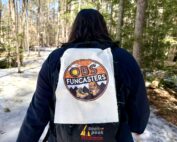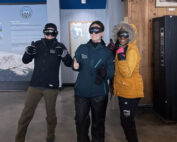Ozone Levels
2018-03-29 09:41:27.000 – Jillian Reynolds, Summit Intern
You may have heard about the current ozone levels in the news or in our forecasts. You may think “What is ozone”? or “What are they basing this level off of”? Well, I am here today to explain what the ozone is, what scale is used to determine what the ozone level is, and what you can do to limit your exposure when the ozone level is high.
What is the ozone? Ozone is a highly reactive gaseous molecule that consists of three oxygen atoms. Ozone occurs naturally in the upper atmosphere as it shields the earth from the sun’s ultraviolet (UV) rays. In the lower atmosphere (ground-level), ozone is formed primarily from chemical reactions of man-made air pollutants coming from vehicles, industries, power plants, and products such as solvents and paints (airnow.gov). Ozone levels and air pollution will often be worse during the afternoon hours in the summer due to its relation to UV radiation and sunlight. During the summertime, the days are longer, there is more sunlight, more UV radiation, and more stability in the atmosphere (latimes.com). These will lead to the air becoming stagnant; it will just sit in one spot and cook.
What scale is used to determine what the ozone level is? The Environmental Protective Agency (EPA) uses a scale called the Air Quality Index (AQI) that calculates five major air pollutants regulated by the Clean Air Act: ground-level ozone, particle pollution, carbon monoxide, sulfur dioxide, and nitrogen dioxide (airnow.gov). The AQI runs from 0 to 500. The higher the AQI value, the greater the level of air pollution and the greater the health concern is, especially for people with respiratory troubles.
Before you venture out and start your day, use this website to check what your current AQI is so you will know how to prepare: https://www.airnow.gov/.
Websites used:
Air Quality Guide for Ozone: https://airnow.gov/index.cfm?action=pubs.aqiguideozone.
Air pollution kicks into high gear in summer months: http://articles.latimes.com/2011/jun/01/health/la-he-summer-health-air-pollution-20110601.
Jillian Reynolds, Summit Intern
Team Flags Return for Seek the Peak’s 25th Anniversary
Team Flags Return for Seek the Peak's 25th Anniversary By MWOBS Staff Mount Washington Observatory is looking forward to continuing a much-loved tradition for Seek the Peak’s 25th Anniversary: Team flags. In inviting teams
Meet Summer Interns Zakiya, Max and Maddie
Meet Summer Interns Zakiya, Max and Maddie By MWOBS Staff We are excited to welcome six teammates to the summit of Mount Washington this summer! During their internship, these students and graduates will play
Saying Goodbye to the Summit
Saying Goodbye to the Summit By Alexis George After an extraordinary last three years working as a Weather Observer and Meteorologist, I am excited to pursue a different career. As sad I as am




